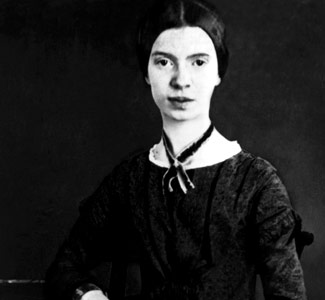Emily Dickinson Inspires Class of New Poets

Emily Dickinson
Details
The poetry of Emily Dickinson is a classroom mainstay, but in Visiting Assistant Professor of English Thomas Devaney's class, the“Belle of Amherst” is more than just a poet to be studied and admired, she's a muse for the students' own work. Those enrolled in this semester's Introduction to Creative Writing Poetry class spent a month studying Dickinson and then writing their own poems based on her work.
“Every semester I teach Dickinson poems, such as ‘I Heard A Fly Buzz' and a suite of her greatest hits,” says Devaney.“But for this assignment I wanted to immerse the students in the larger body of her work.”
Devaney created an internal class blog as a central place to collect all of the students' poems and as a way for the students to share and enjoy their classmates' work. It was so successful that Devaney decided to create a public blog, featuring the best poems from the project, to show off the fruits of his talented students' labor.
He chose Dickinson because of his love of her work, his belief that she is one of the most original American poets and his sense of the ambitious possibilities her poems could suggest. Though Devaney admits that Dickinson's poems, with their unorthodox syntax and famous use of dashes, presented formal demands to his introductory-level students, he was pleased with the poems created and surprised to realize that even the ones that strayed from their reference point circled back in the end in purposeful ways.
“The students were not always able to follow her lead in every way,” says Devaney.“At first, either because of direct imitation, or strange translation of what Dickinson is doing, many of the poems didn't work. But something started to happen about three weeks in. The students started to let go of fully understanding the poems and started to inhabit some of Dickinson's more subtle movements. In the end we certainly raised the bar on our conversation about poetry and their own poems because of the encounter with her work.”
And for the students, the fact that the object of their study was long dead and far removed from their own era and generation (Dickinson died in 1886) had seemingly no bearing on how contemporary or vital her works felt to them.
“You know, Dickinson and [rapper] Lil Wayne are surprisingly similar,” says Sam Fox '14, one of Devaney's students.“Both are completely predictable and variable at the same time. Just look at the way they rhyme. I think it's clear that they both write, first and foremost, for themselves. With artists like these, you can't help but be frustrated and inspired at once.”
Devaney held a public reading for his class, called“Our Emily Dickinson,” in November. At the event in Woodside Cottage, students read aloud not only their own poems inspired by Dickinson's work, but also her originals.
“I really enjoyed the reading,” says Farida Esaa '14, another of the Dickinson class participants.“It was nice to share poems with my classmates and other members of the Haverford community. My favorite part was definitely hearing other people read Emily Dickinson poems aloud—it certainly made me think about them differently. Other students read at a different pace and with a different kind of forcefulness than I do. Or, they may choose to pause after a line, which I would not, or speed through a part where I would take my time. From a reading, you get to see what someone thinks is an important or meaningful aspect of a poem.”
Devaney agrees and thinks that the whole Dickinson project has taught him a lot about a poet he's long enjoyed and his own strengths and weaknesses.
“What happens when you immerse a 19 year-old college student in the work of one of the most original poets of 19th century America?” he asks.“The student poems are strange and strong and show their own limits and quirks, and push both beyond and into [the Dickinson poems they reference] in their own ways.”
--Rebecca Raber
Read some of the poems written by Devaney's class and inspired by Emily Dickinson's work here.



